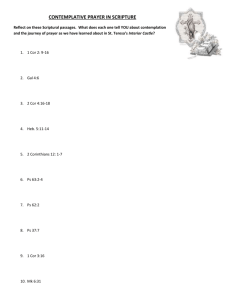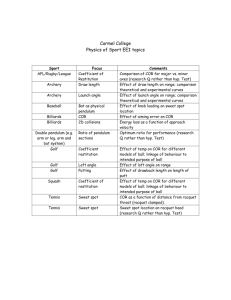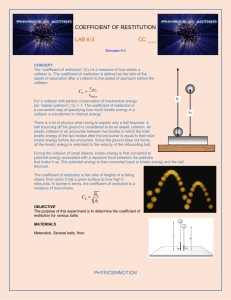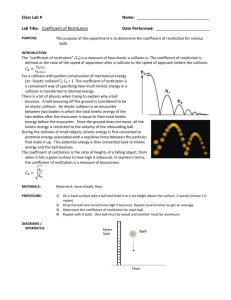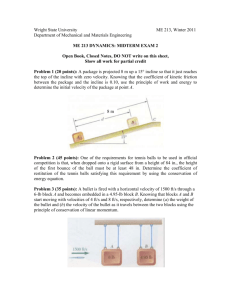Coefficient of Restitution Lab: Physics Experiment
advertisement
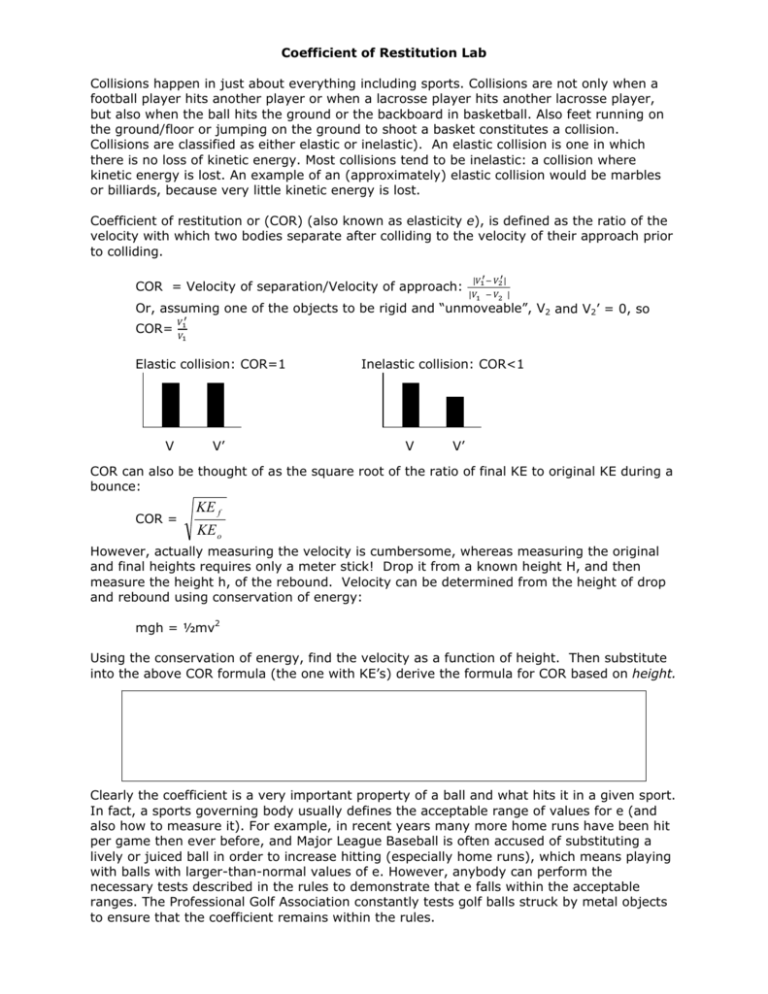
Coefficient of Restitution Lab Collisions happen in just about everything including sports. Collisions are not only when a football player hits another player or when a lacrosse player hits another lacrosse player, but also when the ball hits the ground or the backboard in basketball. Also feet running on the ground/floor or jumping on the ground to shoot a basket constitutes a collision. Collisions are classified as either elastic or inelastic). An elastic collision is one in which there is no loss of kinetic energy. Most collisions tend to be inelastic: a collision where kinetic energy is lost. An example of an (approximately) elastic collision would be marbles or billiards, because very little kinetic energy is lost. Coefficient of restitution or (COR) (also known as elasticity e), is defined as the ratio of the velocity with which two bodies separate after colliding to the velocity of their approach prior to colliding. COR = Velocity of separation/Velocity of approach: | | | | Or, assuming one of the objects to be rigid and “unmoveable”, V2 and V2’ = 0, so COR= Elastic collision: COR=1 V V’ Inelastic collision: COR<1 V V’ COR can also be thought of as the square root of the ratio of final KE to original KE during a bounce: COR = KE f KE o However, actually measuring the velocity is cumbersome, whereas measuring the original and final heights requires only a meter stick! Drop it from a known height H, and then measure the height h, of the rebound. Velocity can be determined from the height of drop and rebound using conservation of energy: mgh = ½mv2 Using the conservation of energy, find the velocity as a function of height. Then substitute into the above COR formula (the one with KE’s) derive the formula for COR based on height. Clearly the coefficient is a very important property of a ball and what hits it in a given sport. In fact, a sports governing body usually defines the acceptable range of values for e (and also how to measure it). For example, in recent years many more home runs have been hit per game then ever before, and Major League Baseball is often accused of substituting a lively or juiced ball in order to increase hitting (especially home runs), which means playing with balls with larger-than-normal values of e. However, anybody can perform the necessary tests described in the rules to demonstrate that e falls within the acceptable ranges. The Professional Golf Association constantly tests golf balls struck by metal objects to ensure that the coefficient remains within the rules. Objective: To determine the coefficient of restitution for several objects (balls). Apparatus: Tennis balls, golf balls, super balls, etc, meter stick. Theory: Most hard bodies are highly resilient while soft bodies are less resilient (do not bounce back after a collision). The coefficient of restitution is a measure of the bounciness of an object during a collision. The coefficient of restitution will be 1 for a perfectly elastic collision and 0 for a completely inelastic collision. In actual practice, collisions are never perfectly elastic. The coefficient of restitution for a body is usually specified for collision with another body made of the same material. Approximate values of the coefficient of restitution (under moderate impact velocities of pairs of spheres of same material) are given below: Table: Ball H (m) h (m) COR Procedure and Data: 1) Drop a ball from a known height (H) and measure the height to which the ball bounces, (h). 2) Repeat several times and use averages of h and H to compute COR for three separate balls. 3) Choose one ball to investigate further. Choose 2 new heights to drop it from and compute COR for each. Discussion: 1) Is mechanical energy conserved in any of the balls you used? If so, which? If not, where did the energy go (be thorough)? 2) Was total energy conserved? Explain. 3) There are at least 3 different ways of showing e as a mathematical relationship. What are they? Extra credit if you can think of more. 4) Could the floor’s surface type be a factor in your COR result? Explain how a “softer” or “harder” floor could affect the results. What would the ideal floor be? 5) Does COR change in relation to the original drop height? What does this tell you about the nature of COR? 6) Describe in a few sentences how the different coefficients of restitution for different balls affects their usefulness for their intended sports.
